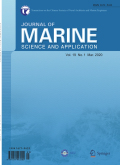- 钛学术文献服务平台 \
- 学术期刊 \
- 工业技术期刊 \
- 大学学报期刊 \
- 船舶与海洋工程学报(英文版)期刊 \
The Effect of Backfilling Stiffness on the Lateral Response of Deeply Buried Pipelines:an Experimental Study
The Effect of Backfilling Stiffness on the Lateral Response of Deeply Buried Pipelines:an Experimental Study
基本信息来源于合作网站,原文需代理用户跳转至来源网站获取
摘要:
Subsea pipelines passing through the shallow area are physically protected against the environmental, accidental, and operational loads by trenching and backfilling. Depending on construction methodology, environmental loads, and seabed soil properties, the stiffness of backfilling material may become largely different from the native ground (softer than native ground in most of the cases). The different stiffness between the backfill and native ground affects the soil failure mechanisms and lateral soil resistance against large pipeline displacements that may happen due to ground movement, landslides, ice gouging, and drag embedment anchors. This important aspect is not considered by current design codes. In this paper, the effect of trench-backfill stiffness difference on lateral pipeline-backfill-trench interaction was investigated by performing centrifuge tests. The soil deformations and failure mechanisms were obtained by particle image velocimetry (PIV) analysis. Three experiments were conducted by using three different backfills including loose sand, slurry, and chunky clay that represent the purchased, natural in-fill, and pre-excavated materials, respectively. The study shows that the current design codes underestimate the lateral soil resistance for small to moderate pipe displacements inside the trench and overestimate it for large lateral displacement, where the pipeline is penetrating into the trench wall.

推荐文章
Using electrogeochemical approach to explore buried gold deposits in an alpine meadow-covered area
Electrogeochemistry
Buried mineral deposit
Ideal anomaly model
Alpine-meadow covered
Ihunze
An experimental study of interaction between pure water and alkaline feldspar at high temperatures a
Alkaline feldspar
Autoclave
High-temperature and high-pressure experiments
An experimental study on dynamic coupling process of alkaline feldspar dissolution and secondary min
Alkaline feldspar
Dissolution rate
Precipitation
Mineral conversion
Secondary porosity
An experimental study on metal precipitation driven by fluid mixing: implications for genesis of car
Metal precipitation
Fluid mixing
Sulfur species
MVT lead–zinc ore deposits
Carbonate-hosted
lead–zinc deposits
内容分析
关键词云
关键词热度
相关文献总数
(/次)
(/年)
文献信息
| 篇名 | The Effect of Backfilling Stiffness on the Lateral Response of Deeply Buried Pipelines:an Experimental Study | ||
| 来源期刊 | 船舶与海洋工程学报(英文版) | 学科 | |
| 关键词 | |||
| 年,卷(期) | 2021,(1) | 所属期刊栏目 | |
| 研究方向 | 页码范围 | 21-33 | |
| 页数 | 13页 | 分类号 | |
| 字数 | 语种 | 英文 | |
| DOI | |||
五维指标
引文网络
引文网络
二级参考文献 (0)
共引文献 (0)
参考文献 (10)
节点文献
引证文献 (0)
同被引文献 (0)
二级引证文献 (0)
1982(3)
- 参考文献(3)
- 二级参考文献(0)
1984(1)
- 参考文献(1)
- 二级参考文献(0)
1994(1)
- 参考文献(1)
- 二级参考文献(0)
2001(1)
- 参考文献(1)
- 二级参考文献(0)
2003(1)
- 参考文献(1)
- 二级参考文献(0)
2010(1)
- 参考文献(1)
- 二级参考文献(0)
2015(1)
- 参考文献(1)
- 二级参考文献(0)
2016(1)
- 参考文献(1)
- 二级参考文献(0)
2021(0)
- 参考文献(0)
- 二级参考文献(0)
- 引证文献(0)
- 二级引证文献(0)
引文网络交叉学科
相关学者/机构
期刊影响力
船舶与海洋工程学报(英文版)
主办单位:
哈尔滨工程大学
出版周期:
季刊
ISSN:
1671-9433
CN:
23-1505/T
开本:
大16开
出版地:
哈尔滨市南岗区南通大街145-1号楼
邮发代号:
14-323
创刊时间:
2002
语种:
eng
出版文献量(篇)
1019
总下载数(次)
0
总被引数(次)
2815
期刊文献
相关文献
推荐文献
- 期刊分类
- 期刊(年)
- 期刊(期)
- 期刊推荐
一般工业技术
交通运输
军事科技
冶金工业
动力工程
化学工业
原子能技术
大学学报
建筑科学
无线电电子学与电信技术
机械与仪表工业
水利工程
环境科学与安全科学
电工技术
石油与天然气工业
矿业工程
自动化技术与计算机技术
航空航天
轻工业与手工业
金属学与金属工艺
船舶与海洋工程学报(英文版)2022
船舶与海洋工程学报(英文版)2021
船舶与海洋工程学报(英文版)2020
船舶与海洋工程学报(英文版)2019
船舶与海洋工程学报(英文版)2018
船舶与海洋工程学报(英文版)2017
船舶与海洋工程学报(英文版)2016
船舶与海洋工程学报(英文版)2015
船舶与海洋工程学报(英文版)2014
船舶与海洋工程学报(英文版)2013
船舶与海洋工程学报(英文版)2012
船舶与海洋工程学报(英文版)2011
船舶与海洋工程学报(英文版)2010
船舶与海洋工程学报(英文版)2009
船舶与海洋工程学报(英文版)2008
船舶与海洋工程学报(英文版)2007
船舶与海洋工程学报(英文版)2006
船舶与海洋工程学报(英文版)2005
船舶与海洋工程学报(英文版)2004
船舶与海洋工程学报(英文版)2003
船舶与海洋工程学报(英文版)2002

 免费查重
免费查重










